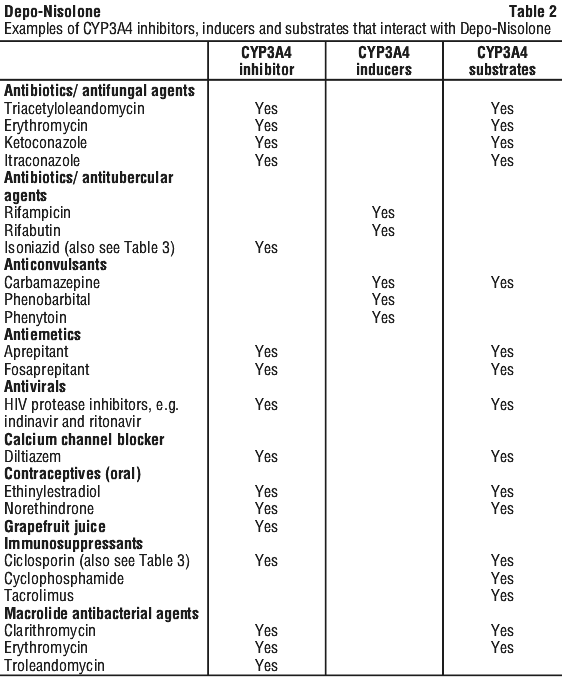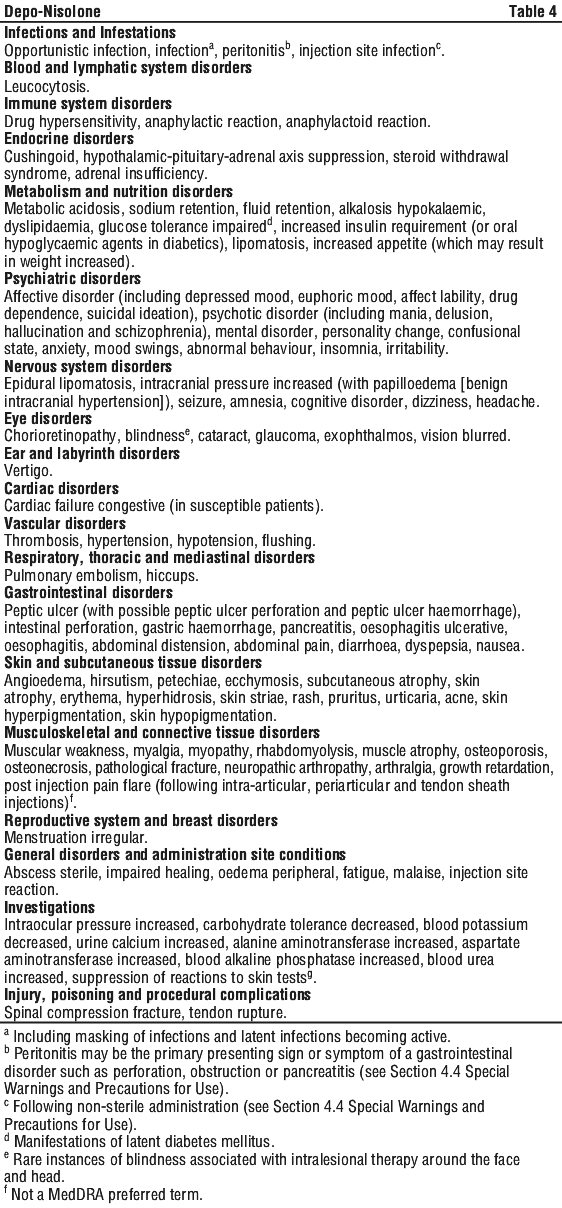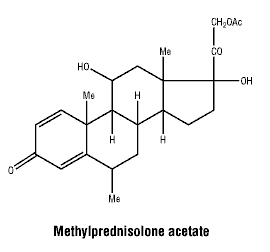SUMMARY CMI
DEPO-NISOLONE®
Consumer Medicine Information (CMI) summary
The full CMI on the next page has more details. If you are worried about using this medicine, speak to your doctor or pharmacist.
1. Why am I being given DEPO-NISOLONE?
DEPO-NISOLONE contains the active ingredient Methylprednisolone. DEPO-NISOLONE is used to treat disorders of many organ systems such as skin, lung, eye, gastrointestinal tract, nervous system, joints and blood.
For more information, see Section 1. Why am I being given DEPO-NISOLONE? in the full CMI.
2. What should I know before receiving DEPO-NISOLONE?
Do not receive DEPO-NISOLONE if you have ever had an allergic reaction to DEPO-NISOLONE or any of the ingredients listed at the end of the CMI, or if you have a severe fungal infection or if you have been given a live vaccine.
Talk to your doctor if you have any other medical conditions, take any other medicines, or are pregnant or plan to become pregnant or are breastfeeding.
For more information, see Section 2. What should I know before receiving DEPO-NISOLONE? in the full CMI.
3. What if I am taking other medicines?
Some medicines may interfere with DEPO-NISOLONE and affect how it works. Tell your doctor or pharmacist if you are taking any other medicines, including any medicines, vitamins or supplements that you buy with or without a prescription from your pharmacy, supermarket or health food shop.
A list of these medicines is in Section 3. What if I am taking other medicines? in the full CMI.
4. How is DEPO-NISOLONE given?
This medicine will be administered under medical supervision. It may be given into a muscle, or into a joint, or into a lesion. Due to the risk of serious side effects, it must not be injected into the spinal cord or into a vein.
More instructions can be found in Section 4. How is DEPO-NISOLONE given? in the full CMI.
5. What should I know while receiving DEPO-NISOLONE?
| Things you should do |
|
| Driving or using machines |
|
| Looking after your medicine |
|
For more information, see Section 5. What should I know while receiving DEPO-NISOLONE? in the full CMI.
6. Are there any side effects?
Side effects include: nausea, vomiting, diarrhoea, headache, dizziness, mood changes, muscle weakness, pain, rash, injection site pain, fragile skin, acne, slow growth, sleeplessness, weight gain, increased sweating, bone weakness or pain, wounds that will not heal, loss in control in your diabetes, changes in menstruation, red, purple or brown patches on your skin, dilated pupils and blurred vision, fever, sore throat, mouth ulcers, itching, wheezing, drowsiness, double vision, anxiety, chest pain, severe chills, severe stomach pain, convulsions, breathlessness, increased thirst. For more information, including what to do if you have any side effects, see Section 6. Are there any side effects? in the full CMI.
FULL CMI
DEPO-NISOLONE®
Active ingredient(s): methylprednisolone acetate
Consumer Medicine Information (CMI)
This leaflet provides important information about DEPO-NISOLONE.
You should also speak to your doctor or pharmacist if you would like further information or if you have any concerns or questions about DEPO-NISOLONE.
Where to find information in this leaflet:
1. Why am I being given DEPO-NISOLONE?
2. What should I know before receiving DEPO-NISOLONE?
3. What if I am taking other medicines?
4. How is DEPO-NISOLONE given?
5. What should I know while receiving DEPO-NISOLONE?
6. Are there any side effects?
7. Product details
1. Why am I being given DEPO-NISOLONE?
DEPO-NISOLONE contains the active ingredient methylprednisolone.
DEPO-NISOLONE is used to treat disorders of many organ systems such as skin, lung, eye, gastrointestinal tract, nervous system, joints and blood. DEPO-NISOLONE works by reducing inflammation and changing the body's natural ability to respond when the immune response is not working properly. It is also used in certain conditions where the adrenal gland doesn't function correctly.
Your doctor may have prescribed DEPO-NISOLONE for another reason.
Ask your doctor if you have any questions about why DEPO-NISOLONE has been prescribed for you.
This medicine is available only with a doctor's prescription.
2. What should I know before receiving DEPO-NISOLONE?
Warnings
DEPO-NISOLONE must not be used:
- If you are allergic to methylprednisolone acetate or any of the ingredients listed at the end of this leaflet
- If you have a severe fungal infection
- It must not be injected into the spinal cord (intrathecal or epidural) or into a vein (intravenous)
- It must not be given by any other unapproved route of administration
- If you have been given a live vaccine
Always check the ingredients to make sure you can use this medicine.
Check with your doctor if you have or have had any other medical conditions, especially the following:
- tuberculosis
- underactive thyroid gland
- kidney or liver disease
- herpes in the eye
- hypoprothrombinaemia (a blood clotting disorder)
- disease of the bowel, e.g., ulcerative colitis or diverticulitis
- stomach ulcers
- diabetes
- emotional problems or mental disorder
- any pus-producing infection
- problems with your heart, including high blood pressure or congestive heart failure
- Cushing's disease (a hormone disorder)
- seizure disorders e.g. epilepsy
- myasthenia gravis (ongoing muscle weakness and chronic fatigue)
- muscle pain, tenderness or weakness from other medicines, especially those used to treat high cholesterol or triglycerides
- thin or weak bones, or bones that tend to break easily (osteoporosis)
- recent head injuries
- blood clots
- systemic sclerosis
- a solid cancer or cancer of the blood because you may be at risk of a very rare, potentially life-threatening condition resulting from a sudden breakdown of tumour cells.
During treatment, you may be at risk of developing certain side effects. It is important you understand these risks and how to monitor for them. See additional information under Section 6. Are there any side effects?
Pregnancy and breastfeeding
Check with your doctor if you are pregnant or intend to become pregnant.
Talk to your doctor if you are breastfeeding or intend to breastfeed.
Children
Long term treatment with corticosteroids can affect growth and development in children. It can also increase the risk of high pressure in the brain. Your doctor will monitor your child closely if your child needs long term treatment with DEPO-NISOLONE.
Elderly
If you are over 65 years old, you may have an increased chance of side effects such as bone weakness possibly leading to fractures. You may also experience fluid retention which may lead to increased blood pressure.
3. What if I am taking other medicines?
Tell your doctor or pharmacist if you are taking any other medicines, including any medicines, vitamins or supplements that you buy without a prescription from your pharmacy, supermarket or health food shop.
Some medicines or food and DEPO-NISOLONE may interfere with each other. Some of these medicines and food include:
- cyclosporin, cyclophosphamide, tacrolimus (medicines used to suppress the immune system e.g. after a transplant)
- isoniazid (a medicine to treat tuberculosis)
- non-steroidal anti-inflammatory drugs [NSAID] such as salicylates or aspirin (medicines used to relieve pain, swelling and other symptoms of inflammation including arthritis)
- some antifungals e.g. ketoconazole, itraconazole
- some antibiotics e.g. rifampicin, erythromycin, clarithromycin
- phenobarbitone, phenytoin, carbamazepine (medicines used to treat epilepsy, convulsions)
- anticoagulants (medicines used to prevent blood clots) e.g. warfarin, heparin
- some immunisations, inoculations or vaccinations
- some diuretics e.g. frusemide, a medicine to help kidneys get rid of salt and water by increasing the amount of urine (wee) produced
- neuromuscular blocking drugs (medicines that block nerve and muscle action) e.g. pancuronium
- medicines used to treat myasthenia gravis (ongoing muscle weakness and chronic fatigue), glaucoma, Alzheimer's disease
- medicines used to treat psychiatric disorders
- medicines used to treat anxiety
- bronchodilators (a type of medicine that opens up the airways in the lungs) used to treat asthma, bronchitis, emphysema, and other lung diseases, e.g., salbutamol
- medicines used to treat diabetes e.g. insulin, glibenclamide and metformin
- anti-nausea medicines e.g. aprepitant, fosaprepitant
- medicines to treat HIV e.g. indinavir, ritonavir
- some medicines to treat blood pressure, heart conditions and stroke, e.g., digoxin and diltiazem
- oral contraceptives e.g. ethinylestradiol, norethisterone
- grapefruit juice
- medicines used to treat breast cancer and hormone disorders.
These medicines and food may be affected by DEPO-NISOLONE or may affect how well it works. You may need different amounts of your medicine or you may need to take different medicines.
Your doctor or pharmacist can tell you what to do if you are taking any of these medicines. They also have a more complete list of medicines to be careful with or avoid while being treated with DEPO-NISOLONE.
Check with your doctor or pharmacist if you are not sure about what medicines, vitamins or supplements you are taking and if these affect DEPO-NISOLONE.
4. How is DEPO-NISOLONE given?
How much to use
This medicine will be administered under medical supervision.
It may be given into a muscle (intramuscularly) or into a joint (intra-articularly) or into a lesion (intralesional). Due to the risk of serious side effects, it must not be injected into the spinal cord (intrathecally or epidural) or into a vein (intravenously).
How and where DEPO-NISOLONE is injected and the dose given will depend on the nature and the severity of your condition. You will be given a different dosage depending on your condition and how you react to the medicine.
If you are given too much (overdose)
Overdose is unlikely with DEPO-NISOLONE. However, repeated frequent doses over a long period of time may cause an increase in side effects.
If you think that you or anyone else may have been given too much DEPO-NISOLONE, you should immediately:
- phone the Poisons Information Centre
- (by calling 13 11 26), or
- contact your doctor, or
- go to the Emergency Department at your nearest hospital.
5. What should I know while receiving DEPO-NISOLONE?
Things you must do
If you become pregnant while you are being treated with DEPO-NISOLONE, tell your doctor.
If you are about to start taking any new medicines, tell your doctor and pharmacist that you are being treated with DEPO-NISOLONE.
Tell all doctors, dentists and pharmacists who are treating you that you are being treated with DEPO-NISOLONE.
Tell your doctor that you are being treated with DEPO-NISOLONE:
- before having any skin tests
- before having any kind of surgery
- if you get a serious injury or infection.
Medicines such as DEPO-NISOLONE can increase the risk of infection and mask symptoms of infection.
Tell your doctor if you notice any of the following:
- fever
- tiredness
- sore or swollen joints.
Your doctor may request you follow a low-salt diet and/or take potassium supplements.
If you are a diabetic, your need for insulin or glucose lowering medicines may increase while being treated with DEPO-NISOLONE.
For patients having this medicine injected into their joints:
- be careful not to put too much stress onto that joint for a while
- ask your doctor how much you can move this joint while it is healing.
Your doctor may reduce the dose of DEPO-NISOLONE gradually if you have been on long-term treatment.
Driving or using machines
Be careful before you drive or use any machines or tools until you know how DEPO-NISOLONE affects you.
DEPO-NISOLONE may cause tiredness, dizziness or slow reflexes in some people.
Do not drive, operate machinery or do anything else that could be dangerous if you feel tired, or if you feel that DEPO-NISOLONE has affected your co-ordination in any way.
Drinking alcohol
No information available.
Tell your doctor if you drink alcohol.
Looking after your medicine
DEPO-NISOLONE will normally be stored in a hospital or doctor's surgery. It should be stored in its original packaging in a cool, dry place where the temperature stays below 30°C. It must not be frozen.
Disposal
Your doctor, nurse or pharmacist will dispose of any left-over medicine.
6. Are there any side effects?
All medicines can have side effects. If you do experience any side effects, most of them are minor and temporary. However, some side effects may need medical attention.
See the information below and, if you need to, ask your doctor or pharmacist if you have any further questions about side effects.
Side effects
| What to do | |
Gastrointestinal (stomach-related)
| Speak to your doctor if you have any of these side effects and they worry you. |
| Call your doctor straight away |
| Tell your doctor immediately, or go to Accident and Emergency at your nearest hospital if you notice any of these symptoms |
DEPO-NISOLONE can also cause chemical imbalances in the blood, swelling of the pancreas (pancreatitis), masking of infections, increased risk of infection, hormone changes, metabolic changes and changes in liver enzymes, increased blood pressure, increased number of white blood cells (leucocytosis), or cataracts. Some of these side effects can only be found when your doctor does tests to check on your progress.
This is not a complete list of all possible side effects. Some people may get other side effects while being treated with DEPO-NISOLONE.
It is very important to tell your doctor if you notice any side effects while being treated with DEPO-NISOLONE.
Do not be alarmed by this list of possible side effects. You may not experience any of them.
Tell your doctor or pharmacist if you notice anything else that may be making you feel unwell.
Other side effects not listed here may occur in some people.
Reporting side effects
After you have received medical advice for any side effects you experience, you can report side effects to the Therapeutic Goods Administration online at www.tga.gov.au/safety/reporting-problems. By reporting side effects, you can help provide more information on the safety of this medicine.
7. Product details
This medicine is only available with a doctor's prescription.
What DEPO-NISOLONE contains
| Active ingredient (main ingredient) | methylprednisolone acetate |
| Other ingredients (inactive ingredients) | Macrogol 3350 Sodium chloride Miripirium chloride |
Do not take this medicine if you are allergic to any of these ingredients.
What DEPO-NISOLONE looks like
DEPO-NISOLONE (AUST R 59388) is a suspension for injection packaged in a glass vial. It is supplied in cartons of 5 x 1 mL or 1 x 1 mL vials.
Who distributes DEPO-NISOLONE
DEPO-NISOLONE is supplied in Australia by:
Pfizer Australia Pty Ltd
Sydney NSW
Toll free number: 1800 675 229
www.pfizermedicalinformation.com.au
This leaflet was prepared in March 2025
Published by MIMS May 2025





 Chemical name: 11β, 17α, 21-trihydroxy -6α-methylpregna -1,4-diene-3,20-dione acetate.
Chemical name: 11β, 17α, 21-trihydroxy -6α-methylpregna -1,4-diene-3,20-dione acetate.